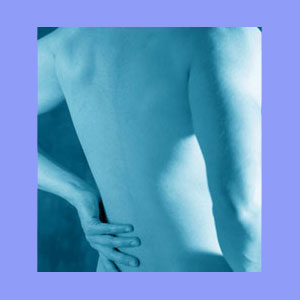
Lower back and buttocks pain is a common combination of symptoms often caused by the same root source of many sciatica syndromes. The lumbar and sacral nerve roots which create the sciatic nerve originate in the lower back and also innervate the buttocks. Therefore, when these nerves are affected by structural constriction, or chemical irritation, the effects can span the entire lower body anatomy, from the lower back to the feet.
The lower back and buttocks are areas of great strength and the muscles that reside there are virtually always in use. When pain comes to visit these anatomical regions, the agony can be so great that the patient is literally incapacitated.
This discussion focuses on explaining the occurrence of lumbar and buttocks symptoms as part of a sciatica syndrome.
Lower Back and Buttocks Pain History
The lumbar and sacral areas work closely with the surrounding muscles to provide our very form as humans. Our upright posture is the result of millions of years of targeted evolution and the muscles in the lower back and buttocks are the very same structures which have facilitated this wonderful development. These vital muscles are working almost non-stop to provide us with the diversity of standing and seated postures we use to perform the great variety of tasks which are expected of us in our daily lives.
It is crucial to realize the structural integrity of this spinal area has been honed over millennia, providing humans with balance, poise, strength and endurance. The lumbar spine has recently earned the reputation as a weak and injury prone region, but the reality of the situation is actually quite the opposite. The lumbar spine is undeniably strong and resilient, although it can suffer from injury or excessive degeneration in some patients, possibly enacting symptoms.
Sciatica Low Back and Butt Pain
Sciatica is known to typically originate in the lower back and deeply affect the large muscles in the buttocks. These gluteal muscles are so strong and yet when sciatica strikes, most patients have difficulty even standing up.
Sciatic nerve pain is most commonly blamed on some abnormal spinal condition, such as a herniated disc or spinal osteoarthritis. While these causations can certainly create pain in some people, they are typically asymptomatic and coincidental to the experienced symptoms. This is obvious when specific testing is accomplished to determine the actual nature of most sciatic nerve complaints.
Sciatica generally affects many patients in a far more widespread pattern than could be produced from the typically diagnosed spinal sources. Additionally, many patients experience muscle spasms and other deep tissue pain not normally associated with a spinal causation.
Despite these inconsistencies, doctors continue to diagnose sciatica due to an unverified spinal source, simply because an lumbar irregularity is present and some radicular pain radiates into the legs. Their limited scope sees this neurological pain as a definitive indicator of nerve root compression, also called a pinched nerve, and no other explanation is even considered. This is a huge blunder and is the primary reason why so many patients do not find relief even after undergoing several treatments which target these incidental lumbar abnormalities.
Now, if a pathological component can be identified and documented, such as correlated symptoms definitively sourced by a pinched nerve in the lumbar spine, therapies will usually prove successful. However, this efficacy is the exception to the rule of failed treatment.
Ischemic Lower Back and Buttocks Pain
The enlightened approach to back care understands that ischemia is the logical source of some sciatica conditions. Ischemia will immediately affect the nerve tissue, causing the variable symptomology associated with sciatica, as well as the muscular spasms and other soft tissue pains not easily explained from a diagnosed spinal source. Ischemia is often to blame for symptomatic expressions which do not correlate to scapegoat structural issues in the lumbar spine.
Ischemia can be created by a structural condition or disease process, but is most often the direct result of the interaction between the mind and body. That’s right, psychosomatic sciatica does exist, and is in fact, one of the more prevalent forms of unresponsive nerve pain in existence today.
Being that the condition is so frequently misdiagnosed, it is no wonder that the majority of treatment options for chronic mindbody sciatic nerve pain demonstrate such poor statistics for actually curing the symptoms.
Lumbar Spine and Buttocks Pain Ordeal
My earliest back pain experiences hit me in these locations the hardest. Yes, I did suffer radiating leg pain starting at the age of 16, but the really agonizing and disturbing sensations were definitely in my lower back, buttocks and rear pelvis. Specifically, I felt as if there was some painful force pushing my pelvis forward, as if my spine were trying to escape out the front of my body. This pressure and pain destroyed my posture and created a very noticeable hypolordosis condition in my lumbar spine. The muscles were strained so much that I completely lost the natural curvature in my lower back. Although this symptomatic expression eventually resolved, it recurred often, especially during the first 12 years of my back pain journey.
Lower back pain is no fun and discomfort in the buttocks muscles is, well, a real pain in the butt: literally! This is no laughing matter. I understand the discomfort of severe pain in the lowest spinal regions. This syndrome makes normal movement impossible and drains the strength from your entire lower body. Pure torture.
If you have not found relief from lower back and buttocks pain after undergoing treatment for lumbar spinal issues, it might be worth expanding your diagnostic possibilities to include muscle imbalances, localized soft tissue injury, neuropathy enacted by diabetes or disease and oxygen deprivation of the lumbar nerve roots or the sciatic nerve itself.





